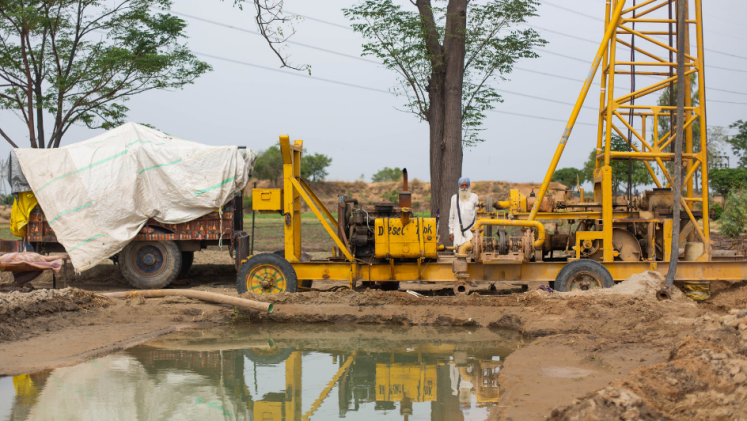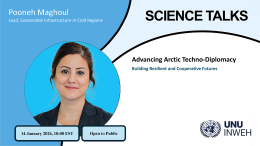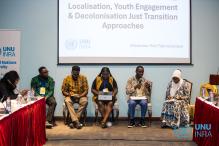Can you imagine a world in which we can no longer rely on the availability of groundwater? Or a world in which you can no longer insure your home because the frequency and intensity of disasters has made insurance unaffordable?
The Interconnected Disaster Risks report 2023 launched today warns about “risk tipping points.” These are points past which the systems we rely on stop functioning as we expect, where the risk of catastrophic impacts increases substantially. When our life-sustaining systems, such as those for food or water, deteriorate, it is not a simple or predictable process. Often, there is a certain threshold of instability in a system that, when crossed, will cause it to fundamentally change or even collapse.
We are fast approaching risk tipping points on multiple fronts. Human actions are behind these rapid and fundamental changes to the planet. We are introducing new risks and amplifying existing ones by indiscriminately extracting our water resources, damaging nature and biodiversity, polluting both Earth and space and destroying our tools and options to deal with disaster risk.
The report analyses six interconnected risk tipping points, selected for their representation of large global issues that impact lives across the world: The report analyses six interconnected risk tipping points, selected for their representation of large global issues that impact lives across the world:
- Accelerating extinctions: A chain reaction to ecosystem collapse
- Groundwater depletion: Draining our water, risking our food supply
- Mountain glaciers melting: Running on thin ice
- Space debris: Losing our eyes in the sky
- Unbearable heat: Living in the unliveable
- Uninsurable future: With rising risks, insurance becomes unreachable
These diverse examples illustrate that risk tipping points extend beyond the single domains of climate, ecosystems, society or technology, but rather are inherently interconnected across them. They share similar root causes and drivers which are embedded in our actions and behaviours that increasingly put pressure on our systems until they are pushed to the brink of collapse. The impacts of these risk tipping points are not isolated to the places where tipping points are crossed but can, as a result of the interconnections, cascade through to other systems and places around the world.
“With these risk tipping points, it is as though we are approaching a cliff that we cannot see clearly ahead of us, and once we fall off the cliff, we can’t easily go back,” says Dr. Zita Sebesvari, one of the lead authors of the report and Deputy Director of UNU-EHS. The report provides a much-needed warning, so that we can take action and change course.”
By understanding risk tipping points, we can make informed decisions and take decisive actions to avert the worst impacts, and forge a new path towards a sustainable and socially just future for all.
“Because of the interconnected nature of these risk tipping points, their drivers, root causes and influences, avoiding them will require more than a single solution”, says Sebesvari. “We will need to develop solutions that bring together different sectors and address the drivers and root causes in a systemic way.”
The 2023 Interconnected Disaster Risks report proposes a new framework to classify and discuss the effectiveness of solutions that can help us avoid or address risk tipping points. Broadly, solutions fall into two main categories: Avoid solutions target risk drivers and root causes to avoid crossing risk tipping points altogether. Meanwhile, Adapt solutions help us better address the negative impacts in case they cannot be avoided, and seek to better position society to live with resulting system changes.
Within each category, there are two options for actions: Delay actions work within the existing ‘business as usual’ system and seek to slow down the progression towards risk tipping points or possible worst impacts. Transform actions involve a fundamental re-imagining of the system itself.
The resulting framework has 4 categories:
- Avoid-Delay
- Avoid-Transform
- Adapt-Delay
- Adapt-Transform
Understanding which of the four categories a solution falls into helps to assess what kind of outcomes it can produce and which trade-offs it may have. For example, in the case of the “Unbearable heat” tipping point, there are weather stations that have already recorded temperatures beyond the tipping point at which human survival is threatened. If this threshold is crossed for more than six hours, a person’s body will be unable to cool itself down and may experience organ failure and brain damage. Human-induced climate change causes a global rise in temperatures, leading to more frequent and intense heatwaves with severe impacts, so an Avoid-Transform solution would be one that transforms our society in such a way that we achieve strong and sustained reductions in emissions of greenhouse gases to halt climate change. This involves a societal change towards low-carbon ways of living, so that these tipping points can be avoided. Meanwhile, an Adapt-Delay solution would be one where we install air conditioners in all buildings in hot climates. This will delay the moment of reaching the risk tipping point for people living in these environments, but it will not prevent us from reaching the risk tipping point eventually. If the air conditioners are powered with fossil fuels, it would contribute to further global warming.
“In our interconnected world, we can all make changes and inspire others towards transforming the way we use our systems to reduce risk,” encourages Caitlyn Eberle, another lead author of the report and senior researcher at UNU-EHS. The report highlights five transformational changes needed to reduce risk in our interconnected systems, such as a shift towards zero waste, a closer connection to nature, global cooperation and trust, consideration for future generations, and shifting to an economic model that is less focused on growth and more on human well-being within planetary boundaries. “Contributing to either a future of increasing risks or a future of sustainability and resilience comes down to our choices and the actions that follow. The choice is ours, and we can act now to create the future we want.”



